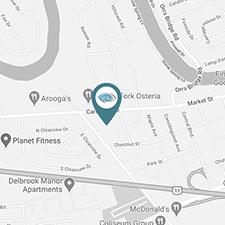Do you have cataracts? Are they worsening and making it more challenging to see the world around you clearly?
If you’re having cataract surgery or are ready to reduce your reliance on visual aids with refractive lens exchange, choosing the best IOL for your vision and personal needs is one of the most significant decisions you will make. Many kinds of IOLs are available, meaning you may be unsure about which one to choose.
Keep reading to learn about 6 tips to help you choose the best IOL and what that could mean for your vision!
What is an IOL?

An IOL, or intraocular lens, is an artificial lens that replaces the eye’s natural lens during cataract surgery. IOLs are usually made of medical-grade silicone, acrylic, or other natural plastic compositions.
During cataract surgery, an IOL replaces a natural lens that has become cloudy and impairs vision. Not only can IOLs help improve your vision after cataract surgery, but they can also correct refractive errors like nearsightedness, farsightedness, and astigmatism.
IOLs come in different focusing powers, like your glasses or contact lenses. Depending on the IOL you choose, they can also correct vision at a single distance or multiple distances.
Many IOLs also come in toric versions, which can improve astigmatism.
An IOL which corrects vision at a single distance is called a monofocal lens.
Because a monofocal lens corrects only one distance, you’ll likely still need visual aids after cataract surgery. Multifocal IOLs are premium IOLs and can correct vision at multiple distances, including up close, at a distance, and everything in between.
Depending on your prescription and the IOL you choose, a premium IOL can reduce or eliminate your need for visual aids.
Do you need cataract surgery?
Choosing the Best IOL
Are you undecided on the best IOL for cataract surgery? Here are six tips to help you make the best decision:
1. Consider Your Lifestyle

Think about the role of your vision in your daily life. Do you work in front of a computer all day and need to be able to see clearly up close?
Or do you enjoy outdoor activities, like mountain biking, that rely on high-quality vision when looking at things further away? Depending on your lifestyle, seeing clearly at all distances could be your priority, making a multifocal IOL an excellent choice.
With the right multifocal IOL, you can reduce your dependence on visual aids after cataract surgery, allowing you to see clearly and live the life you want without boundaries.
2. Think About Your Vision Goals
Undergoing cataract surgery can mean finally reducing your reliance on corrective aids. Instead of depending on glasses and contact lenses, you can see what it’s like to see clearly and achieve your vision goals.
With the right IOL, you can achieve these goals, whether it’s having better vision while golfing, seeing clearly to knit sweaters for your grandchildren, or enjoying a leisurely hike with friends along the river. Consider your goals: do you spend a lot of time using the computer?
You’ll want to find an IOL that makes it easy to see well at all distances without sacrificing your ability to see up close. Do you not mind using visual aids after cataract surgery?
A monofocal IOL is worth considering if you don’t mind using reading glasses or other visual aids after the procedure. Before choosing an IOL, it’s essential to consider these things to ensure you pick one that fits your visual needs in every way.
3. Factor in Astigmatism
Only one intraocular lens is specifically designed to correct astigmatism. This IOL is a toric lens.
If you have astigmatism, toric IOLs are usually the best IOL to consider. Astigmatism changes the shape of the eye, meaning that the cornea is more of a football shape rather than round like a basketball. This irregularity in shape makes it more challenging for patients with astigmatism to properly fit most standard IOLs.
Toric IOLs have a unique shape that can compensate for the irregular curvature of the cornea that causes astigmatism. Many IOLs, including premium IOLs, come in toric models to ensure patients with astigmatism can enjoy the same visual benefits.
4. Consider Designing Your Vision with the Light Adjustable Lens
For the ultimate in customizable vision, consider the Light Adjustable lens. This cutting-edge IOL is adjusted after implantation, allowing you to preview and fine-tune your vision until it meets your preferences.
The Light Adjustable lens is made of unique photosensitive material that is adjusted with UV light treatments. Only a few quick treatments are needed to provide customized vision once you’ve recovered from cataract surgery.
5. Review Insurance Coverage and Out-of-Pocket Costs
Your budget should also be a factor before choosing an IOL. The best IOL is the one that both improves your vision and makes financial sense for you.
While Medicare usually covers cataract surgery when you choose a monofocal lens, it will not cover the cost of a premium IOL. Premium IOLs require an out-of-pocket cost, making it essential to consider your financial needs. It can be helpful to compare the one-time price of a premium IOL versus the ongoing expenses of additional corrective aids after cataract surgery.

6. Consult Your Cataract Surgeon
Your cataract surgeon’s experience and expertise make them an invaluable resource when considering the best IOL. They can give you informed recommendations based on your individual needs.
Your cataract surgeon can also help you set realistic expectations about the possible outcomes of your procedure and your choice of IOL. Realistic expectations about the quality of your vision after cataract surgery lead to higher patient satisfaction.
When you feel fully informed about IOLs and the options available, you’ll feel more confident that you are choosing the best IOL for you. You can enjoy the clearest, crispest vision after cataract surgery with the right IOL!
Do you need cataract surgery? Achieve better vision by requesting an appointment at Memorial Eye Institute in Harrisburg or Camp Hill, PA, today! Isn’t it time to say so long to cataracts and hello to better sight?



